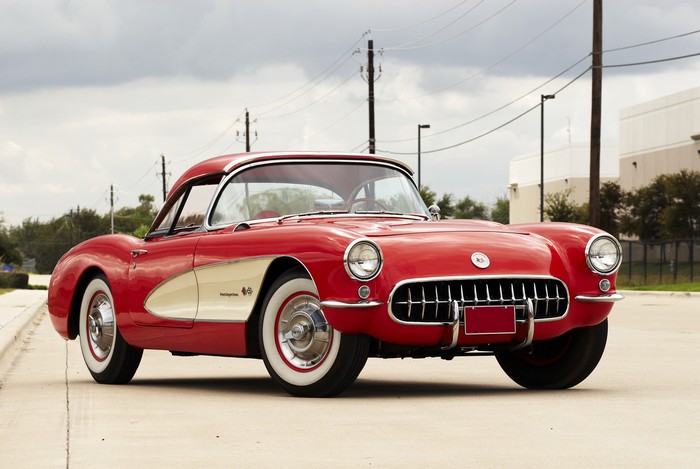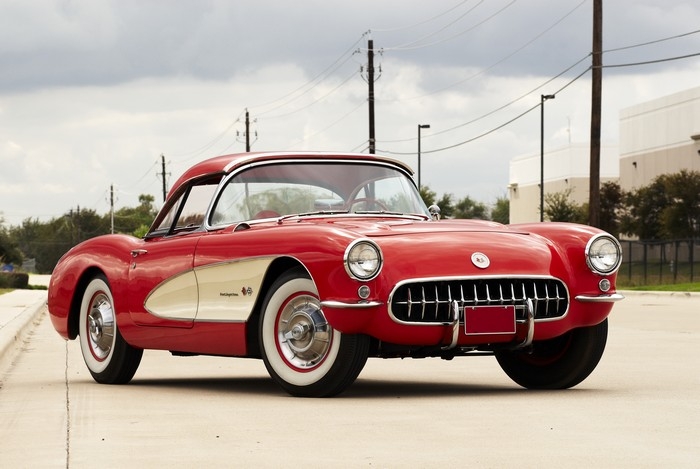
This 1957 Corvette is confirmed by its VIN as having been delivered with the ultimate “283/283” V8 with Rochester fuel injection and high-lift cam, which still resides under the hood today. It is also equipped with a T-10 4-speed transmission, a Positraction rear axle, a signal-seeking AM radio, and both a soft top and a removable body-color hard top. A high-quality restoration, performed in previous care, saw the car refinished in Venetian Red over red upholstery, after which the car was on display in a Corvette museum for some time.
The car is still very much as it was when the restoration was completed, and it offers an unbeatable combination of performance and good looks. To many, this is exactly what the mental picture of a 1957 Corvette describes: red on red, fuel injection, good options, both tops, and ready to go to a new home.
SCM Analysis
Detailing
| Vehicle: | 1957 Chevrolet Corvette 283/283 Fuelie convertible |
| Years Produced: | 1957 |
| Number Produced: | 713 (RPO 579B) |
| Original List Price: | $4,060, as equipped |
| SCM Valuation: | $74,500–$121,000 |
| Tune Up Cost: | $350 |
| Distributor Caps: | $50 |
| Chassis Number Location: | VIN on frame and door pillar |
| Engine Number Location: | Assembly code on engine pad |
| Club Info: | NCRS |
| Website: | www.ncrs.org |
| Alternatives: | 1965 Corvette 396/425 convertible, 1957 Pontiac Bonneville convertible, 1957 Ford Thunderbird F-code (supercharged) |
| Investment Grade: | B |
This Fuelie Corvette, Lot 117, sold for $129,250, including buyer’s premium, at RM’s Amelia Island auction in Amelia Island, FL, on March 9, 2013.
Zora Duntov’s focus from the beginning of his time with GM and the Corvette team had been the car’s performance on the track. 1957 was the year he made it happen, turning Corvette into the fastest production car made in America. The ’57 283/283 fuel-injected Corvette was also the first GM motor to achieve one horsepower per cubic inch — a very big deal in 1957.
The ’57 Corvette was the last of the single-headlight series and was offered with many new factory options. They included 3:70s, 4:11s and 4:56s, all with Positraction; HD brakes and suspension; CR 4-speed transmissions; 26 color/trim options; 220-, 245- and 270-hp V8s with single or dual 4-bbl carbs; and the injected 250-hp and 283-hp engines.
GM built 6,339 1957 Corvettes. 713 cars were ordered with RPO 579B (11% of the cars built), which was the option code for the 283/283 with mechanical lifters, a high-lift cam and Rochester fuel injection, like our subject car.
There was also an RPO 579E option, which featured the same 283/283 Fuelie engine but with cold-air induction and a mechanical tachometer on the steering column. Those cars, known as “Airbox” cars, were the top performance Corvettes available — they were race cars in street clothes — but the additional options increased their base price of $3,176 by almost 50%. Only 43 were completed.
Today, original Airbox 283s are worth exponentially more money than a standard 283/283 Fuelie — from $375,000 to more than $500,000 — and finding one for sale is next to impossible. For the collector looking for the high point in ’50s Corvettes on a more realistic budget, the RPO 579B standard 283/283 Fuelie is the car to have.
A good look
I was at the Amelia Island Ritz Carlton when this red/red Fuelie crossed RM’s auction block for more than $129k.
It was one of the first cars to go through the auction and it was readily viewable prior to entering the turntable in the auction room. March 9 was a clear, sunny day on Amelia Island, and this Corvette showed very well. The exterior paint quality was very good, the interior, seats, dash, gauges and rugs all period-correct and in excellent condition.
But there were a couple of noteworthy issues: The fitment of the trunk was noticeably different from the doors and hood. The engine block casting number and date were appropriate for the car, but the stamp-pad surface did not appear to be typical of factory production — it could have been stamped much later. The car also had a 4-speed close-ratio transmission and radio.
Mixed parts, minced words, and the numbers game
The VIN number of this car is listed as E57S102825. GM records show that it came off the assembly line in St. Louis on or about March 14, 1957. That creates a problem, as 4-speed synchromesh, close-ratio transmissions were not available until several hundred more 1957 Corvettes had been produced… sometime in April. Based off that, I’m willing to bet this car didn’t come with the 4-speed from the factory. It should have been delivered with a 3-speed box.
And there were other issues as well. Re-read the seller’s description. In part: “The 1957 Corvette offered today is confirmed by its VIN number as having been delivered with the ultimate 283/283…which still resides under the hood today.” Corvette specialists will tell you that there has never been a way to tell what a Corvette’s horsepower was by its VIN number. Additionally, does the seller mean that the original 283/283 is still under the hood, or is he saying that the Corvette was originally fuel-injected? These are important points for serious Corvette buyers.
The next sentence is also confusing: “…. The car [was] refinished in Venetian Red over red upholstery.” Does the seller mean it was redone in red on red or was it born with another color combination and refinished in his choice of colors? Nowhere does the description mention anything about “original,” “numbers matching,” or provenance. What are those words worth?
Breaking down the sale
I talked with several experts about solid-axle Corvettes, including NCRS Judging Chairman Roy Sinor, Corvette race car expert/historian Jim Gessner and the NCRS 1956–57 National Team Leader John St Peter. We agreed that for the demographic attending the Amelia Island Concours and its attendant RM auction, this was a fair price for both the seller and buyer. These are high-level, high-class events, and the auctions often sell cars for a premium.
I have no way of knowing whether the bidders knew about this car’s block-stamping inconsistency, cared about the trunk fitment, transmission issue, or were concerned about the seller’s relatively vague description. And to the average buyer, depending on their intent for the car, it may not really matter.
From the standpoint of originality and condition, this car might not do well with NCRS or Bloomington Gold, but in today’s marketplace, an undocumented car with the right color and options, the go-fast look, and FI badges can ring the bell just as easily as a well-documented car — after all, it was a red/red ’57 Fuelie in great cosmetic shape. I can’t fault the buyer for just wanting to own it.
At the end of the day, the price paid reflected the buyer’s satisfaction with the car. And while it may not set the judging field on fire, there’s great value in use. My advice to the new owner: Drive the car.
(Introductory description courtesy of RM Auctions.)
